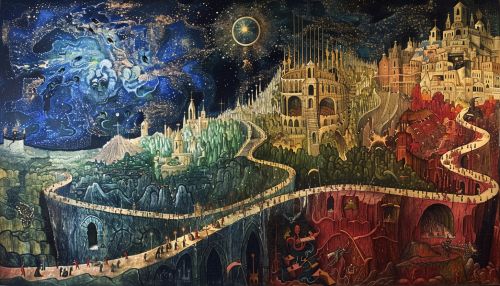The Divine Comedy
Overview
The Divine Comedy (La Divina Commedia) is an epic poem written by the Italian poet Dante Alighieri. It is widely considered one of the greatest works of world literature. The poem is divided into three parts: Inferno (Hell), Purgatorio (Purgatory), and Paradiso (Paradise). Each part consists of 33 cantos, with an additional introductory canto in Inferno, bringing the total to 100 cantos. The narrative describes Dante's journey through the three realms of the dead, guided by the Roman poet Virgil and later by Beatrice, Dante's ideal woman.


Historical Context
The Divine Comedy was written in the early 14th century, during the late Middle Ages. This period was marked by significant political and social upheaval in Italy, particularly in Dante's hometown of Florence. The poem reflects the complex political landscape of the time, including the conflicts between the Guelphs and Ghibellines, two factions that supported the papacy and the Holy Roman Emperor, respectively. Dante himself was exiled from Florence due to his political affiliations, and his experiences in exile deeply influenced the themes and tone of the poem.
Structure and Style
The poem is written in terza rima, a rhyming verse stanza form that consists of an interlocking three-line rhyme scheme (aba, bcb, cdc, etc.). This structure not only provides a rhythmic and musical quality to the poem but also reflects the intricate and interconnected nature of the narrative. Each canto is composed of lines written in hendecasyllabic meter, which is a line of verse with eleven syllables.
Inferno
Inferno is the first part of The Divine Comedy and describes Dante's journey through Hell. Hell is depicted as nine concentric circles of torment located within the Earth. Each circle corresponds to a specific sin and its corresponding punishment. The deeper Dante travels, the more severe the sins and punishments become. The circles are:
- Limbo: The unbaptized and virtuous pagans.
- Lust: The lustful are blown about by violent winds.
- Gluttony: The gluttonous are forced to lie in a vile slush.
- Greed: The greedy are divided into two groups, hoarders and wasters, who joust with heavy weights.
- Wrath: The wrathful fight each other on the surface of the river Styx.
- Heresy: Heretics are trapped in flaming tombs.
- Violence: Divided into three rings, each for different types of violence.
- Fraud: The fraudulent are punished in ten bolgias (ditches).
- Treachery: The treacherous are frozen in a lake of ice.
Purgatorio
Purgatorio is the second part of The Divine Comedy and describes Dante's ascent of the Mountain of Purgatory. Purgatory is depicted as a seven-tiered mountain, each tier corresponding to one of the seven deadly sins. Souls in Purgatory undergo purification to prepare for their eventual ascent to Paradise. The seven terraces are:
- Pride: The proud are burdened with heavy stones.
- Envy: The envious have their eyes sewn shut.
- Wrath: The wrathful are enveloped in acrid smoke.
- Sloth: The slothful engage in ceaseless activity.
- Avarice: The avaricious and prodigal lie face down on the ground.
- Gluttony: The gluttonous suffer from extreme hunger and thirst.
- Lust: The lustful are purified by walking through flames.
Paradiso
Paradiso is the third and final part of The Divine Comedy and describes Dante's journey through the nine celestial spheres of Heaven. Each sphere is associated with a particular virtue and is inhabited by souls who embody that virtue. The spheres are:
- The Moon: The inconstant.
- Mercury: The ambitious.
- Venus: The lovers.
- The Sun: The wise.
- Mars: The warriors of the faith.
- Jupiter: The just rulers.
- Saturn: The contemplatives.
- The Fixed Stars: The faithful.
- The Primum Mobile: The angels.
Beyond the Primum Mobile lies the Empyrean, where God resides. Dante's journey culminates in a direct vision of God, an experience that transcends human language and comprehension.
Themes and Symbolism
The Divine Comedy is rich with themes and symbolism. Key themes include the nature of sin, redemption, and divine justice. The poem also explores the relationship between human free will and divine providence. Symbolically, the journey represents the soul's path towards God, with Hell symbolizing the consequences of sin, Purgatory representing purification, and Paradise embodying the ultimate union with the divine.
Influence and Legacy
The Divine Comedy has had a profound influence on literature, art, and culture. Its vivid imagery and complex allegory have inspired countless works of art, including illustrations by Gustave Doré and Sandro Botticelli. The poem has also been translated into numerous languages and remains a subject of scholarly study. Its impact extends beyond literature, influencing theology, philosophy, and even political thought.
